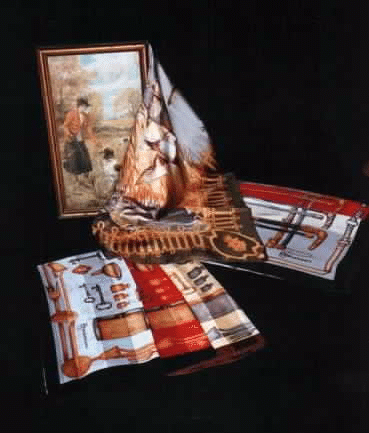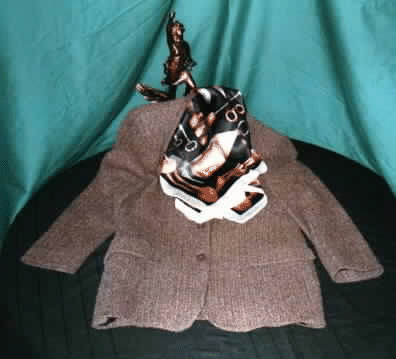 |
| Continued from Ties page... A man was generally judged by the beauty of his cravat and the skill he used in typing it. A fashion manual of the day described 32 different ways to know a cravat, each one more complex than the next. Over 100 different knots were in use, while men of individuality expressed their personality in original creations. Ponder over this when typing a four-in-hand or Windsor. It is also said that Beau Brummel, one of history's most famous influences int eh 1800's, used to spend hours knotting his tie, since the proper gentleman of the day believed he could distinguish himself from the common people by knowing how to ttie his cravat to perfection. Touching another man's tie was also considered a serious matter. According to one book of the period, ground for a duel. And a certain M. Le Blanc, who instructed men in the fine and sometimes complex are of tying a tie noted, "The grossest insult that can be offered to a man comme il faut is to seize him by the cravat; in this place blood can wash out he stain upon the honor of either party." "With an evening coat and a white tie, anybody, even a broker, can gain reputation for being civilized. -Oscar Wilde from "The Picture of Dorian Gray, 1891 Stars in the purple dusk above the rooftops Pale in teh saffron mist and seen to die, And I myself on a swiftly tilting planet Stand befor a glass and tie my tie -Conrad Aiken (American writer and critic, 1889-1973) How to Distinquish a Good Tie The proper width of a tie, and one that will never be out of style, is 3-1/2 inches (2-3/4 to 3-1/2 inches are also acceptable). As long as the proportions of men's clothing remain true to a man's body shape, this width will set the proper balance. If the relationship is proper, the knot will never be so large that it spreads the collar or forces it open, now will it be so small that it will become lost in the collar. Standard neckties come in lengths anywhere from 52 to 58 inches long. After being tied, the tips of the necktie should be long enough to reach the waist band of the trousers (the ends of teh tie should either be equal, or the smaller one just a fraction shorter). After you've confirmed the appropriateness of a ties's shape, next feel the fabric. If it's made of silk and it feels rough to the touch, then it is a silk of inferior quality. Silk that is not supple is very much like hair that's been dyed too often. If care hasn't been taken in the inspection of ties, you may find misweaves and puckers. All fine ties are cut on the bias, which means they have been cut across the fabric. This allows tehm to fall straight after the knot has been tied, without curling. A simple test consists of holding a tie across your hand. If it begins to twirl in the air, it was probably not cut on the bias and it should not be purchased. Quality neckties want you to see everything: they have nothing to hide. Originally, neckties were cut from a single square of silk, which was then folded seven times in order to give the tie a rich fullness. Today the price of silk and the lack of skilled artisans prohibit this form of manufacture. Ties now derive their body and fullness by means of an additional lining. Besides giving body to the tie, the lining helps the tie hold its shape. The finest quality ties today are lined with 100 percent wool and are generally made only in Europe. Most other quality ties use a wool mixture. The finer the ties, the higher the wool content. After you have examined the lining, take a look at the tie just above the spot where the two sides come together to form an inverted V. In most quality ties, you will find a stitch joining the back flap. This is called the bar tack, and it helps maintain the shape of the tie. Now, if you can, open up the tie as far as possible and look for a loose black thread. This thread is called teh slipstitch and was invented by a man named Joss Langsdorf in the 1920's to give added resilience to the tie. The fact that the tie can move along this thread means that it won't rip when it is being wrapped tightly around your neck, and it will, when removed, return to its original shap. Finally, take the tie in your hand and run your finger down its length. You should find three separate pieces of fabric stitched together, not two, as in most commercial ties. This construction is used to help the tie conform easily to the neck. |
 |
| Ducks |
| Riding Sticks |
| Locks & Keys |
| 026 |
| 027 |
| 028 |
| 029 |
| 030 |
| 031 |
| 032 |
| 100% Silk Scarves signed by Barbieri - $26.00 DUCKS - Satin finish Color 026 Olive with gold brocade design on border, center patter, flying ducks in multi-browns, yellows and gray RIDING STICKS - Satin and sheer woven finish Color 027 Black border with beige center. Multi-colored gray and beige riding sticks pattern Color 028 Burgundy border with red center. Barbieri logo woven into background. Multi-beige, gold and gray riding stick pattern Color 029 Black border with light gray center. Multi-tan, beige and gray riding stick pattern LOCKS & KEYS - Satin finish Color 030 Black border with pale gray center. Multi-gold and gray keys, locks, weights, etc. pattern Color 031 Black border with red center. Multi-gold, beige and gray keys, locks, weights, etc. pattern Color 032 Navy blue border with gray center. Multi-gold, tan and gray keys, locks, weights, etc. patter |
| SQUARE SCARVES 34" x 34" Sauare 100% SIlk Scarves |
 |
| LOCKS & KEYS |
| 033 |
| LOCKS & KEYS Color 033 White border with black center. Multi-colored tans, beige and gray keys, locks, weights, etc. pattern |
 |
| Regal |
| 035 |
| 034 |
| REGAL - 2" Sheer and satin woven background finish - $26.00 Color 034 Navy border with white, aqua and navy blue center and edges. Multi-colored gold scrollborder pattern. Design of multi-colored gold chains with bright pin stones and multi-colored gray pearls Color 035 Black border with white center and edges. Multi-colored gold scroll border pattern. Design of multi-colored gold chains with red stones and multi-colored gray pearls |
| Next Pg. |